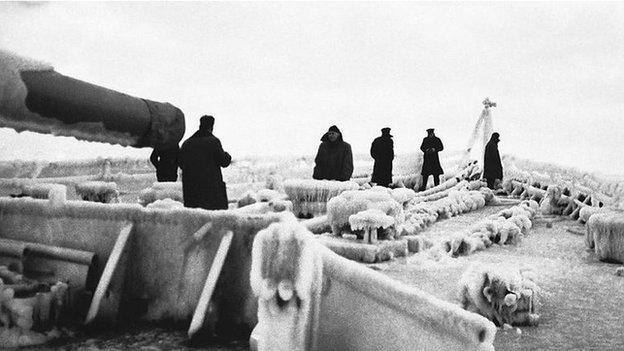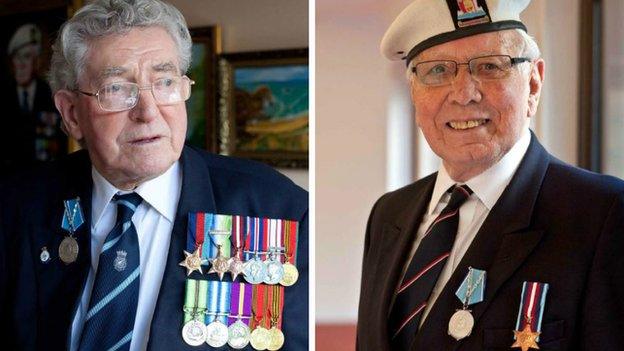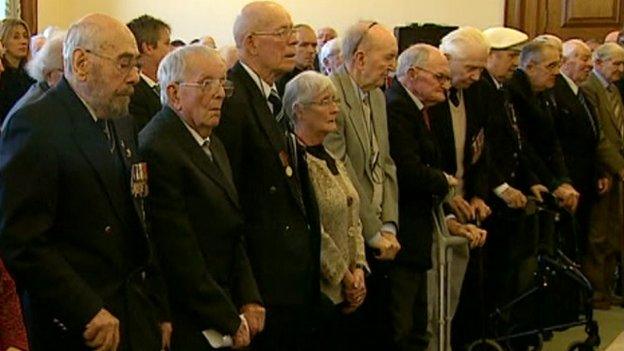Heroes of Arctic convoys remembered in new exhibition
- Published

They were the brave men who worked in some of the harshest conditions of the war, with their icy hell only matched with a fear of the German U-boats below.
Now, some of the Arctic convoy veterans from World War Two will be remembered in an exhibition which opens in Edinburgh next week.
The stories of 16 veterans will be celebrated in a display at the St Mary's Episcopal Cathedral in association with Legion Scotland.
The "Arctic Convoys - Men and Ice" exhibition tells the stories of survivors of the Arctic Convoys who have connections with the Edinburgh area.
The free exhibition, which opens on Monday, shows how the gruelling campaign changed the lives of the men who endured extreme hardship.
In the Arctic convoys, four million tonnes of cargo - mainly armaments and essential supplies - were sent by Britain to the Soviet Union during the Second World War.
Merchant ships, escorted by Royal Navy vessels, braved the northern route of 2,500 miles of deadly seas, including the Arctic Ocean, from 1941 to 1945.

The stories of Harold O'Neill (left) and David Dunsmuir will be featured at the exhibition.
David Dunsmuir from Blantyre was one of those who served on the convoys.
Working at Waddie, the stationer and printer in Edinburgh, the 18-year-old was called up in September 1943.
He served as a gunner on HMS Diadem.
The grandfather of two said: "The thing that struck me immediately was I hadn't understood how dangerous or strong water is.
"I saw 35ft waves hitting ships and bending steel. The biggest concern was the cold. Everything was freezing up and we had to keep chipping away at the ice, keeping the guns free."
After the war, David returned to Waddie and worked his way up to a director of the company. He retired after working for 47 years with the firm.
The 89-year-old, who lives in Edinburgh, returned to Russia this year to commemorate the end of the war in Europe.
'Worst in the world'
Harold O'Neill was another who served. Now 93, he enlisted in 1941 and worked as a steward on HMS Sumba and HMS Liverpool.
Mr O'Neill, who now lives in Haddington, remembers one particular night on the convoy when a gale scattered the vessels over a distance of 150 nautical miles and caused severe icing on the ships, causing some of the ships to become too heavy and in danger of capsizing.
He said: "Then the Germans came. I was chopping ice at the funnel. Enemy machine gun fire erupted around us."
The exhibition will also feature photographs and tapestries.
The Very Reverend Dr Forbes, the Provost of St Mary's Cathedral, said "Men, as the psalmist states, do 'go down to the sea in ships', and Britain as a sea-faring nation is no exception.
"This exhibition which the cathedral is proud to host, tells of exceptional men whose ships sailed across the roof of the world to help an ally in the fight against fascism."
Kevin Gray, chief executive officer of Legion Scotland, said: "The Arctic Convoys were described by Winston Churchill as the 'worst journey in the world'.
"Legion Scotland is honoured to be part of the exhibition sharing the extraordinary experiences of these veterans and also pays tribute to those who didn't make it home."
The exhibition runs from 27 July until 31 August.
- Published20 December 2014
